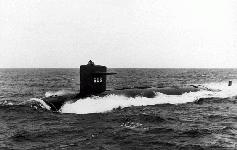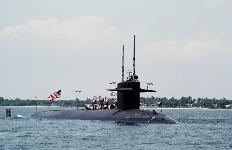






These submarines were originally designated the THRESHER class, but the USS Thresher (SSN 593) was lost 200 miles off the coast of New England on 10 April 1963. According to investigators, a seawater pipe in the aft engine spaces broke, spraying water into the engine room and shorting one of the main electrical bus boards. The sub lost electrical power and couldn't operate the reactor. Darkness, a sea mist, and sheer terror inhibited the crew from manually actuating the valves. The aft part of the sub filled up with water and tilted down. With no power to get back on line, the sub drifted down to crush depth and imploded. A ghastly death for an entire crew, and one the US Navy vowed never to allow happen again.
The ill-fated USS Thresher (SSN-593) and her crew did not suffer in vain. Out of that terror and the lessons learned grew the SubSafe Program. Through this program, every submarine in the US Fleet, every pressure hull integrity-related system aboard those subs, and every pressure-related part within those systems must be certified as being 100% safe for use on a submarine. The goals are to ensure that in case of a casualty, the ship and its crew can be recovered and to ensure that the integrity of the material used on the ship can operate at design test depth. Directly related to the Thresher tragedy, sea-connected joints can no longer be brazed; they must now be welded. The SubSafe program brought other controls, too. Now when an emergency arises aboard a sub, all vital equipment which sailors would need quick access to in the event of an emergency is clearly marked and easily accessible. At all times an operator is one second away from flipping the emergency main ballast tanks to vent, so the sub can rise to the surface.
The Navy took other steps to ensure such a tragedy never occur again. Following the recommendations of a special Presidential Deep Submergence Review Group, the Deep Submergence Rescue System was developed in the mid-1960s. The deep submergence rescue vehicles Mystic (DSRV 1) and Avalon (DSRV 2) of the Deep Submergence Unit are the genesis of that program. The last three units of this class [Flasher, Greenling, Gato] were modified during construction to incorporate lessons learned from the loss of the Thresher. Fitted with heavier machinery and a larger sail, they were ten feet longer than the other units of the class to correct stability problems caused by weight growth.The SSN 605 Jack was fitted with an experimental direct-drive propulsion system coupled with a pair of counter-rotating propellers. The engine spaces were lengthened by ten feet and the shaft was lengthened by seven feet to accomodate this additional equipment. Although counter-rotating propellers had previously produced impressive gains in speed on the experimental Albacore, in this instance the results were disappointing and led to the abandoment of this approach in subsequent submarine design.
Specifications | |
| Displacement | 4,200 tons submerged 3,540 tons Light Displacement |
| Length | 278 feet 297 feet SSN-605 292 feet SSN-613-615 |
| Beam | 32 feet |
| Draft | 28 ft Maximum Navigational Draft |
| Speed | official - 20-plus knots actual - 30 knots [35 mph] submerged actual - 15 knots [17 mph] tactical |
| Operating Depth |
official: 400 feet Actual: 1300 feet [400 meters] test depth Actual: 1900 feet [600 meters] collapse depth |
| Construction | High Yield-80 (HY-80) steel alloy |
| Power Plant | One S5W nuclear reactor two steam turbines, one shaft, 15,000 shp |
| Armament | MK 48 Torpedoes, four torpedo tubes UUM-44A SUBROC UGM-84A/C Harpoon MK 57 deep water mines MK 60 CAPTOR mines |
| Sensors |
BQQ-5 bow-mounted sonar TB-16 Towed Sonar Array |
| Complement | 143 |
| Unit Operating Cost Annual Average | $10,000,000 [source: [FY1996 VAMOSC] |
| Builders | SSNs 594, 595, Mare Island Naval Shipyard; 596, 607, 621, Ingalls Shipbuilding; 603, 604, 612, New York Shipbuilding; 605, 606, Portsmouth Naval Shipyard; 613-615, General Dynamics' Electric Boat Division |
Ships | ||||||
| Name | Number | Builder | Homeport | Ordered | Commissioned | Decommissioned |
| Thresher | SSN-593 | Portsmouth NSY | Portsmouth | 15 Jan 1958 | 03 Aug 1961 | 10 Apr 1963 |
| Permit | SSN-594 | Mare Island NSY | San Diego | 27 Jan 1958 | 29 May 1962 | 23 Jul 1991 |
| Plunger | SSN-595 | Mare Island NSY | 23 Mar 1959 | 21 Nov 1962 | 02 Feb 1990 | |
| Barb | SSN-596 | Ingalls | 1958 | 24 Aug 1963 | 10 Mar 1989 | |
| Pollack | SSN-603 | New York SB | 03 Mar 1959 | 26 May 1964 | 01 Mar 1989 | |
| Haddo | SSN-604 | New York SB | San Diego | 03 Mar 1959 | 16 Dec 1964 | 12 Jun 1991 |
| Jack | SSN-605 | Portsmouth NSY | New London | 13 Mar 1959 | 31 Mar 1967 | 11 Jul 1990 |
| Tinosa | SSN-606 | Portsmouth NSY | New London | 17 Dec 1958 | 17 Nov 1964 | 15 Jan 1992 |
| Dace | SSN-607 | Ingalls | 03 Mar 1959 | 04 Apr 1964 | 02 Dec 1988 | |
| Guardfish | SSN-612 | New York SB | San Diego | 09 Jun 1960 | 20 Dec 1966 | 04 Feb 1992 |
| Flasher | SSN-613 | Electric Boat | San Diego | 09 Jun 1960 | 22 Jul 1996 | 14 Sep 1992 |
| Greenling | SSN-614 | Electric Boat | Portsmouth | 09 Jun 1960 | 03 Nov 1967 | 18 Apr 1994 |
| Gato | SSN-615 | Electric Boat | New London | 09 Jun 1960 | 25 Jan 1968 | 25 Apr 1996 |
| Haddock | SSN-621 | Ingalls | Vallejo | 24 Aug 1960 | 22 Dec 1967 | 07 Apr 1993 |


